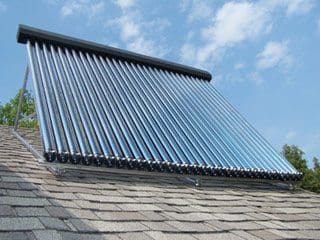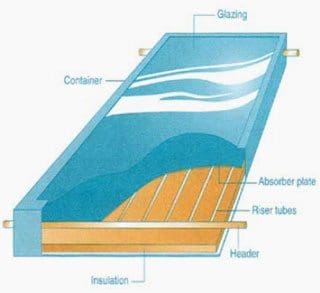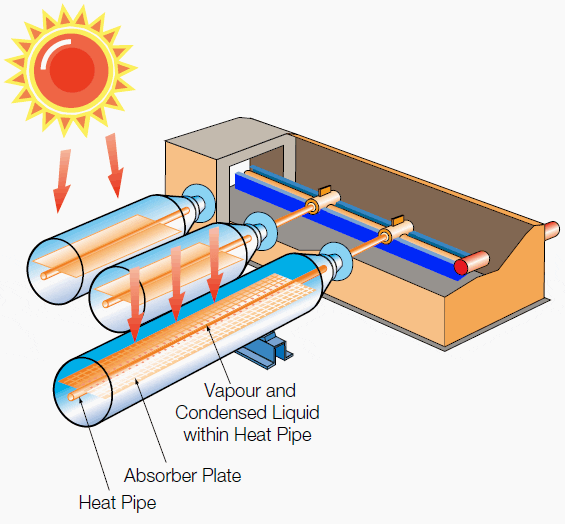 |
| Typical solar collector installed on the roof |
Solar energy (solar radiation) is collected by the solar collector’s absorber
plates. Selective coatings are often applied to the absorber plates to
improve the overall collection efficiency.
A thermal fluid absorbs
the energy collected. There are several types of solar collectors to
heat liquids. Selection of a solar collector type will depend on the
temperature of the application being considered and the intended season
of use (or climate).
The most common solar collector types are:
unglazed liquid flatplate collectors; glazed liquid flat-plate
collectors; and evacuated tube solar collectors.
Unglazed liquid flat-plate collectors
Unglazed
liquid flat-plate collectors, as depicted in Figure 8, are usually made
of a black polymer. They do not normally have a selective coating and
do not include a frame and insulation at the back; they are usually
simply laid on a roof or on a wooden support. These low-cost collectors
are good at capturing the energy from the sun, but thermal losses to the
environment increase rapidly with water temperature particularly in
windy locations.
As a result, unglazed collectors are commonly
used for applications requiring energy delivery at low temperatures
(pool heating, make-up water in fish farms, process heating applications, etc.); in colder climates they are typically only operated in the
summer season due to the high thermal losses of the collector.
 |
| Figure 8: System Schematic for Unglazed Flat-Plate Solar Collector. |
Glazed liquid flat-plate collectors
 |
| Figure 9: System Schematic for Glazed Flat-Plate Solar Collector. |
In
glazed liquid flat-plate collectors, as depicted in Figure 9, a
flat-plate absorber (which often has a selective coating) is fixed in a
frame between a single or double layer of glass and an insulation panel
at the back.
Much of the sunlight (solar energy) is prevented from escaping due to the glazing (the “greenhouse effect”).
These
collectors are commonly used in moderate temperature applications (e.g.
domestic hot water, space heating, year-round indoor pools and process
heating applications).
Evacuated tube solar collectors
Evacuated
tube solar collectors, as depicted in Figure 10, have an absorber with a
selective coating enclosed in a sealed glass vacuum tube.
They
are good at capturing the energy from the sun; their thermal losses to
the environment are extremely low. Systems presently on the market use a
sealed heat-pipe on each tube to extract heat from the absorber (a
liquid is vaporised while in contact with the heated absorber, heat is
recovered at the top of the tube while the vapour condenses, and
condensate returns by gravity to the absorber).
 |
| Figure 10: System Schematic for Evacuated Tube Solar Collector |
Evacuated
collectors are good for applications requiring energy delivery at
moderate to high temperatures (domestic hot water, space heating and
process heating applications typically at 60°C to 80°C depending on
outside temperature), particularly in cold climates.
No comments:
Post a Comment